Die Anleitung zum Struts2 für den Anfänger
1. Die Vorstellung
Das Dokument wird nach der Quelle von ... geschrieben
- Eclipse 4.6 (NEON)
- Struts 2 (2.3.20)
Sie sehen gerade die Hinweise bei der Erstellung von Applikation Hello World Struts mit der Benutzung von Annotation zu konfigurieren. Sie können die gleichen Beispiele der Benutzung von XML zur Konfiguration bei:... sehen
2. Das Maven Project erstellen
- File/New/Other..
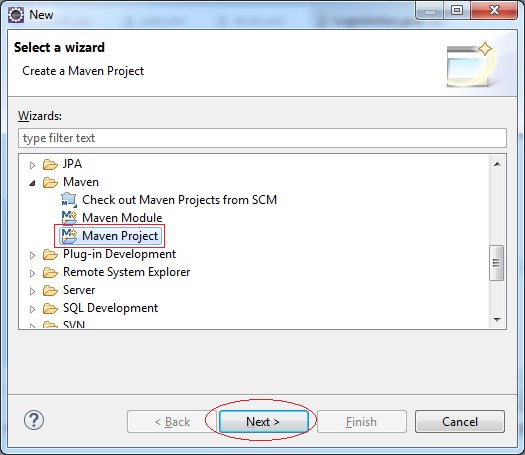
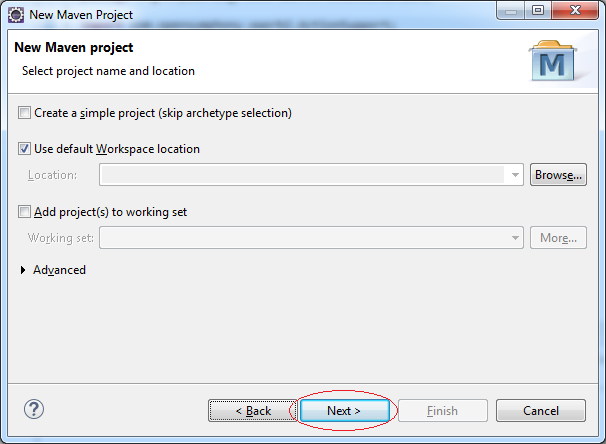
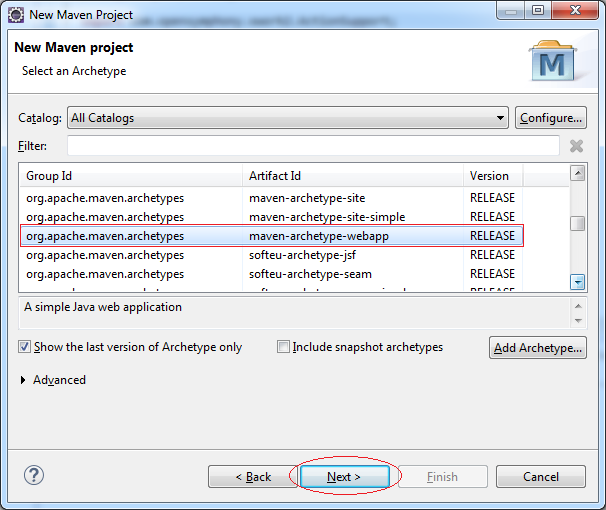
Geben Sie ein
- Group Id: org.o7planning
- Artifact Id: Struts2Annotation
- Package: org.o7planning.struts2annotation
Project wurde erstellt und es gibt die Fehleranmeldung. bitte haben Sie keine Sorge. Der Grund ist, dass Sie die Bibliothek Servlet noch nicht melden
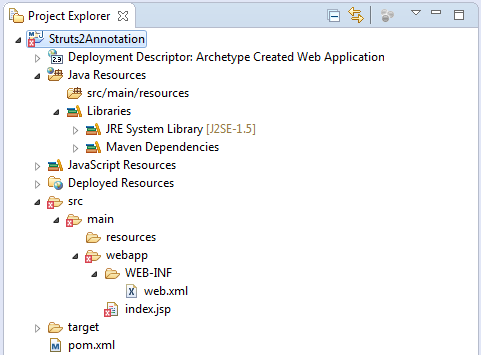

Das ist das Bild vom Project nach der Erledigung
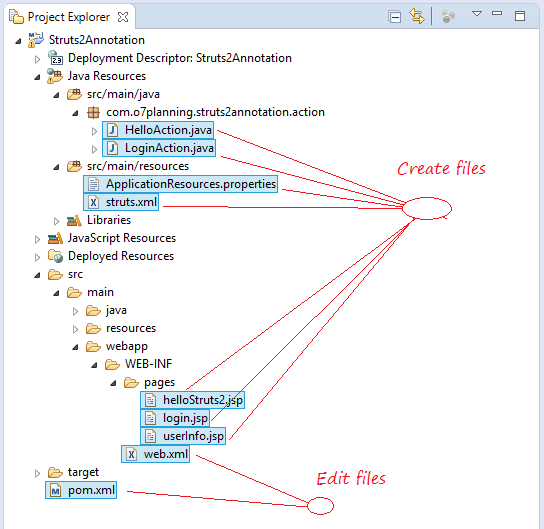
3. Maven konfigurieren
Die Konfiguration des Maven zur Meldung der benutzenden Bibliothek, einschließend Servlet, Struts2. Gleichzeigtig die Konfiguration des Maven Tomcat Plugin zur Durchführung der Web-Applikation direkt auf die Eclipse.
pom.xml
<project xmlns="http://maven.apache.org/POM/4.0.0"
xmlns:xsi="http://www.w3.org/2001/XMLSchema-instance"
xsi:schemaLocation="http://maven.apache.org/POM/4.0.0
http://maven.apache.org/maven-v4_0_0.xsd">
<modelVersion>4.0.0</modelVersion>
<groupId>org.o7planning</groupId>
<artifactId>Struts2Annotation</artifactId>
<packaging>war</packaging>
<version>0.0.1-SNAPSHOT</version>
<name>Struts2Annotation Maven Webapp</name>
<url>http://maven.apache.org</url>
<dependencies>
<dependency>
<groupId>junit</groupId>
<artifactId>junit</artifactId>
<version>3.8.1</version>
<scope>test</scope>
</dependency>
<!-- Servlet Library -->
<!-- http://mvnrepository.com/artifact/javax.servlet/javax.servlet-api -->
<dependency>
<groupId>javax.servlet</groupId>
<artifactId>javax.servlet-api</artifactId>
<version>3.1.0</version>
<scope>provided</scope>
</dependency>
<!-- Jstl for jsp page -->
<!-- http://mvnrepository.com/artifact/javax.servlet/jstl -->
<dependency>
<groupId>javax.servlet</groupId>
<artifactId>jstl</artifactId>
<version>1.2</version>
</dependency>
<!-- JSP API -->
<!-- http://mvnrepository.com/artifact/javax.servlet.jsp/jsp-api -->
<dependency>
<groupId>javax.servlet.jsp</groupId>
<artifactId>jsp-api</artifactId>
<version>2.2</version>
<scope>provided</scope>
</dependency>
<!-- http://mvnrepository.com/artifact/org.apache.struts/struts2-core -->
<dependency>
<groupId>org.apache.struts</groupId>
<artifactId>struts2-core</artifactId>
<version>2.3.20</version>
</dependency>
<!-- http://mvnrepository.com/artifact/org.apache.struts/struts2-convention-plugin -->
<dependency>
<groupId>org.apache.struts</groupId>
<artifactId>struts2-convention-plugin</artifactId>
<version>2.3.20</version>
</dependency>
</dependencies>
<build>
<finalName>Struts2Annotation</finalName>
<plugins>
<!-- Config: Maven Tomcat Plugin -->
<!-- http://mvnrepository.com/artifact/org.apache.tomcat.maven/tomcat7-maven-plugin -->
<plugin>
<groupId>org.apache.tomcat.maven</groupId>
<artifactId>tomcat7-maven-plugin</artifactId>
<version>2.2</version>
<!-- Config: contextPath and Port (Default: /Struts2Annotation : 8080) -->
<!-- <configuration> <path>/</path> <port>8899</port> </configuration> -->
</plugin>
</plugins>
</build>
</project>4. Struts & web.xml konfigurieren
Benutzen Sie Webapp >= 3
web.xml
<?xml version="1.0" encoding="UTF-8"?>
<web-app xmlns:xsi="http://www.w3.org/2001/XMLSchema-instance"
xmlns="http://java.sun.com/xml/ns/javaee"
xsi:schemaLocation="http://java.sun.com/xml/ns/javaee
http://java.sun.com/xml/ns/javaee/web-app_3_0.xsd"
id="WebApp_ID" version="3.0">
<display-name>Struts2Annotation</display-name>
<filter>
<filter-name>struts2</filter-name>
<filter-class>
org.apache.struts2.dispatcher.ng.filter.StrutsPrepareAndExecuteFilter
</filter-class>
</filter>
<filter-mapping>
<filter-name>struts2</filter-name>
<url-pattern>/*</url-pattern>
</filter-mapping>
<welcome-file-list>
<welcome-file>/WEB-INF/pages/helloStruts2.jsp</welcome-file>
</welcome-file-list>
</web-app>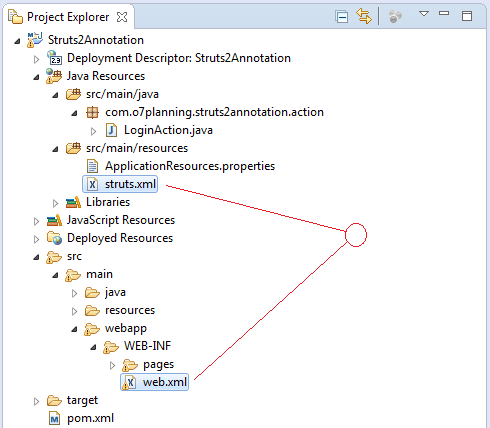
struts.xml ist eine File resource, die in src/main/resources gestellt wird, und diese File hat die Aufgabe zur Konfiguration von struts.
struts.xml
<?xml version="1.0" encoding="UTF-8" ?>
<!DOCTYPE struts PUBLIC
"-//Apache Software Foundation//DTD Struts Configuration 2.0//EN"
"http://struts.apache.org/dtds/struts-2.0.dtd">
<struts>
<constant name="struts.enable.DynamicMethodInvocation" value="false" />
<constant name="struts.devMode" value="false" />
<constant name="struts.custom.i18n.resources" value="ApplicationResources" />
</struts>5. Code Project
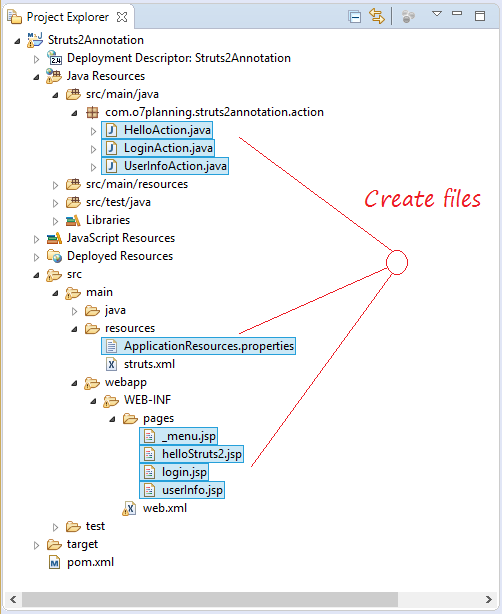
ApplicationResources.properties
label.username= Username
label.password= Password
label.login= Login
error.login= Invalid Username/Password. Please try again._menu.jsp
<%@ page language="java" contentType="text/html; charset=UTF-8"
pageEncoding="UTF-8"%>
<a href="${pageContext.request.contextPath}/">Home</a>
|
<a href="${pageContext.request.contextPath}/login">Login</a>
<br>helloStruts2.jsp
<html>
<head>
<title>Struts 2 - Hello World</title>
</head>
<body>
<jsp:include page="_menu.jsp" />
<h2>Hello Struts2</h2>
</body>
</html>login.jsp
<%@ page contentType="text/html; charset=UTF-8"%>
<%@ taglib prefix="s" uri="/struts-tags"%>
<html>
<head>
<title>Struts 2 - Login Application</title>
</head>
<body>
<jsp:include page="_menu.jsp" />
<h2>Struts 2 - Login Application</h2>
<s:actionerror />
<s:form action="/login" method="post">
<s:textfield name="username" key="label.username" size="20" />
<s:password name="password" key="label.password" size="20" />
<s:submit method="execute" key="label.login" align="center" />
</s:form>
<br>
Username: admin, password: admin123
</body>
</html>userInfo.jsp
<%@ page contentType="text/html; charset=UTF-8"%>
<%@ taglib prefix="s" uri="/struts-tags"%>
<html>
<head>
<title>User Info</title>
</head>
<body>
<jsp:include page="_menu.jsp" />
<h2>Howdy, ${loginedUsername}...!</h2>
</body>
</html>HelloAction.java
package com.o7planning.struts2annotation.action;
import org.apache.struts2.convention.annotation.Action;
import org.apache.struts2.convention.annotation.Result;
import com.opensymphony.xwork2.ActionSupport;
@Action(value = "hello", //
results = { //
@Result(name = "helloPage", location = "/WEB-INF/pages/helloStruts2.jsp")
} //
)
public class HelloAction extends ActionSupport {
private static final long serialVersionUID = 1L;
@Override
public String execute() {
return "helloPage";
}
}LoginAction.java
package com.o7planning.struts2annotation.action;
import javax.servlet.http.HttpServletRequest;
import javax.servlet.http.HttpSession;
import org.apache.struts2.ServletActionContext;
import org.apache.struts2.convention.annotation.Action;
import org.apache.struts2.convention.annotation.Result;
import com.opensymphony.xwork2.ActionSupport;
@Action(value = "login", //
results = { //
@Result(name = "showForm", location = "/WEB-INF/pages/login.jsp"), //
@Result(name = "loginError", location = "/WEB-INF/pages/login.jsp"), //
// loginSuccess: Redirect to /userInfo
@Result(name = "loginSuccess", type="redirect", location= "/userInfo") //
} //
)
public class LoginAction extends ActionSupport {
private static final long serialVersionUID = 7299264265184515893L;
private String username;
private String password;
public LoginAction() {
}
@Override
public String execute() {
if (this.username == null && this.password == null) {
return "showForm";
}
HttpServletRequest request = ServletActionContext.getRequest();
// Username und password sind gültig.
if ("admin".equals(this.username) && "admin123".equals(this.password)) {
HttpSession session = request.getSession();
// Die Speicherung von userName in session.
session.setAttribute("loginedUsername", this.username);
return "loginSuccess";
}
// Username oder password sind nicht richtig
else {
// ** In ApplicationResources.properties sehen
String message = getText("error.login");
addActionError(message);
return "loginError";
}
}
public String getUsername() {
return username;
}
public void setUsername(String username) {
this.username = username;
}
public String getPassword() {
return password;
}
public void setPassword(String password) {
this.password = password;
}
}UserInfoAction.java
package com.o7planning.struts2annotation.action;
import org.apache.struts2.convention.annotation.Action;
import org.apache.struts2.convention.annotation.Result;
import com.opensymphony.xwork2.ActionSupport;
@Action(value = "userInfo", //
results = { //
@Result(name = "userInfoPage", location = "/WEB-INF/pages/userInfo.jsp")
} //
)
public class UserInfoAction extends ActionSupport {
private static final long serialVersionUID = 1L;
@Override
public String execute() {
return "userInfoPage";
}
}6. Die Applikation laufen
Um die Applikation direkt auf Eclipse durchzulaufen, sollen Sie die Durchführung vom Tomcat Maven Plugin.konfigurieren
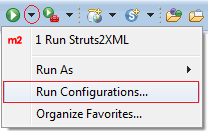
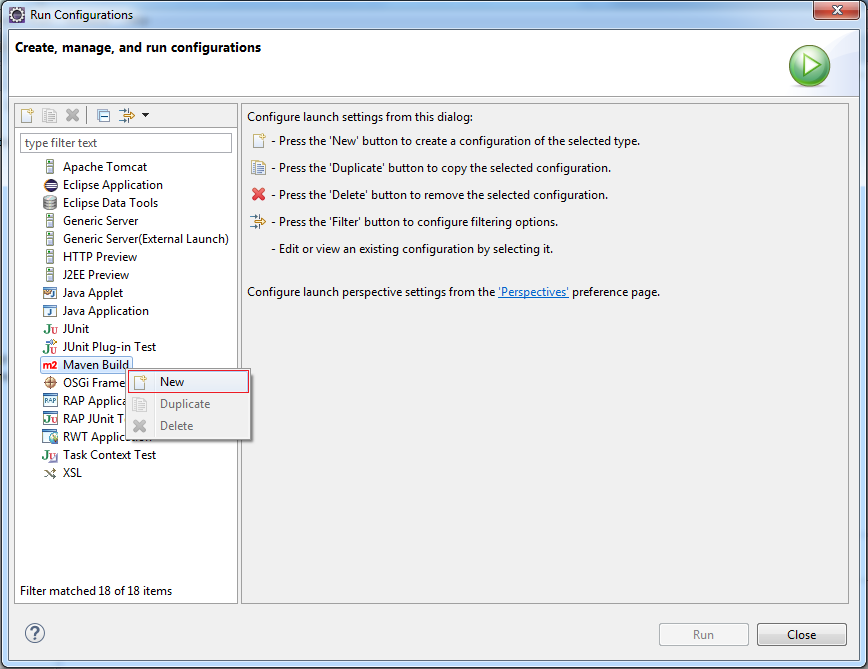
Geben Sie ein
- Name: Run Struts2Annotation
- Base Directory: ${workspace_loc:/Struts2Annotation}
- Goals: tomcat7:run
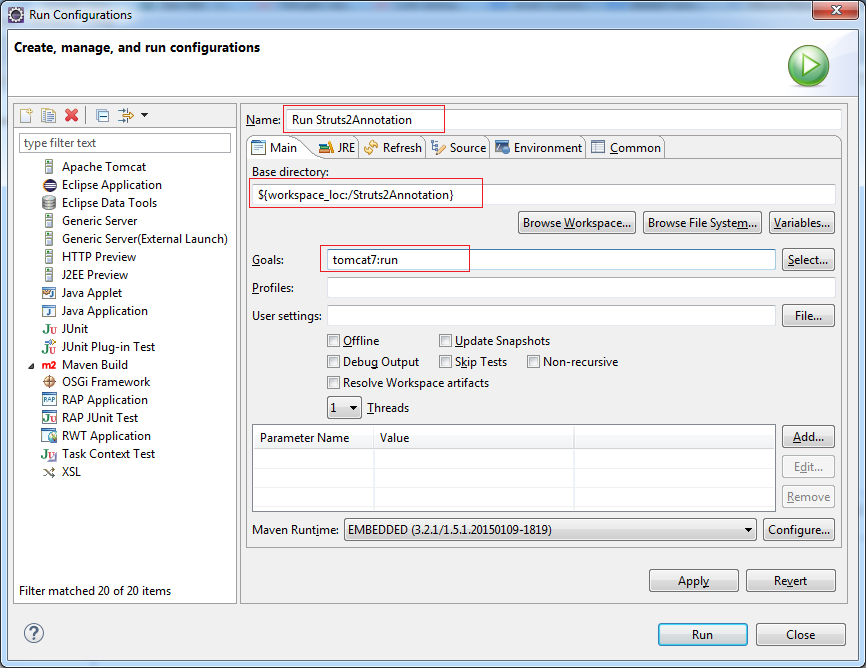
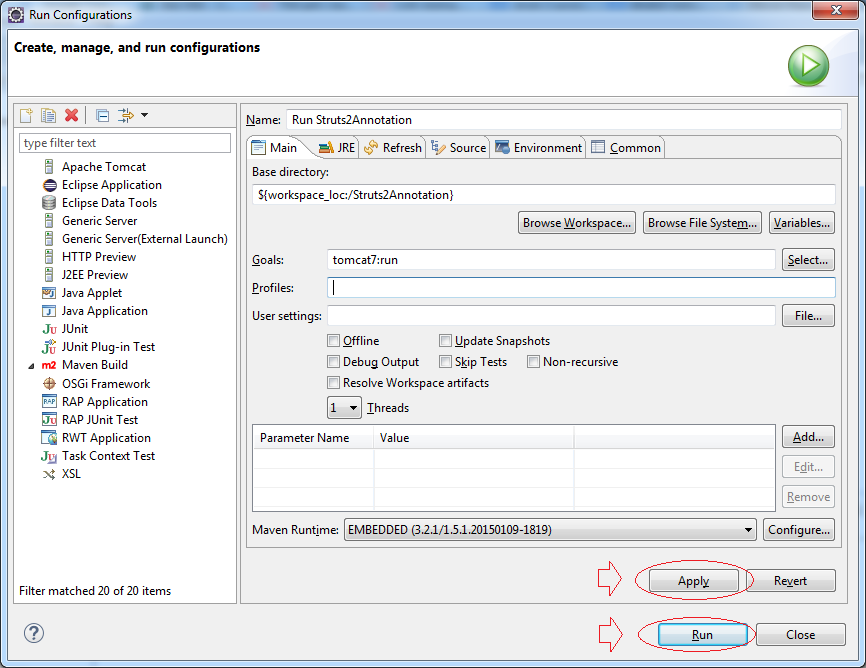
Tomcat Maven Plugin ist gelaufen

Auf dem Browser geben Sie den Pfad
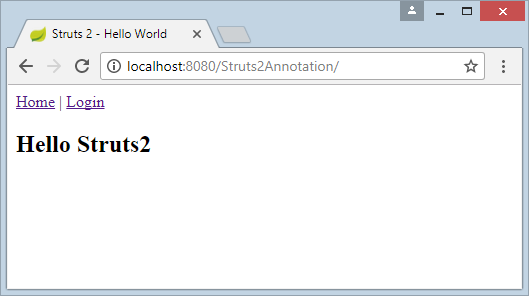
Und URL
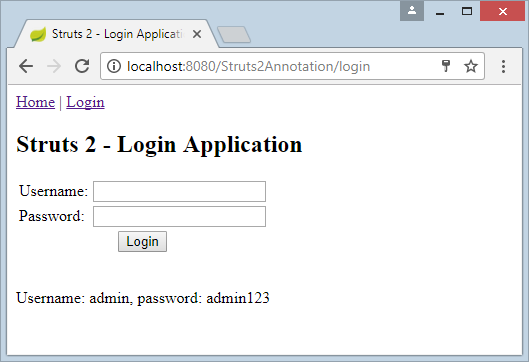
Wenn Sie den nicht-richtigen Username/password eingeben, wird die Seite wie unten angezeigt
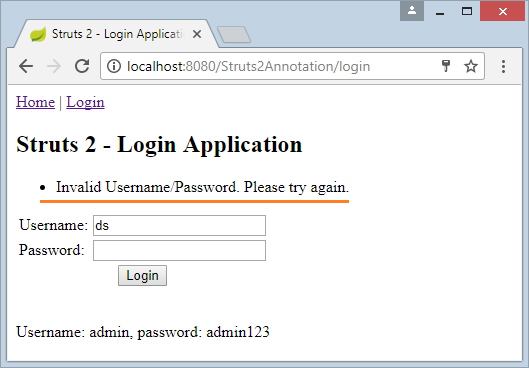
Im Fall vom richtigen Eingabe
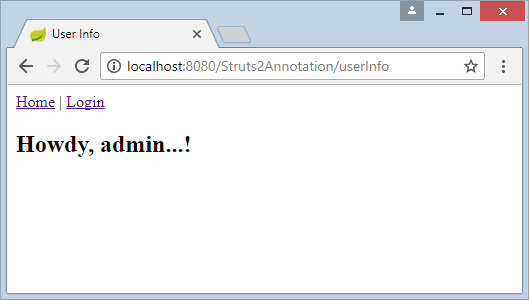
7. Der Operationsgrundsatz vom Struts 2 (Annotaion version)
Das flow von der Applikation
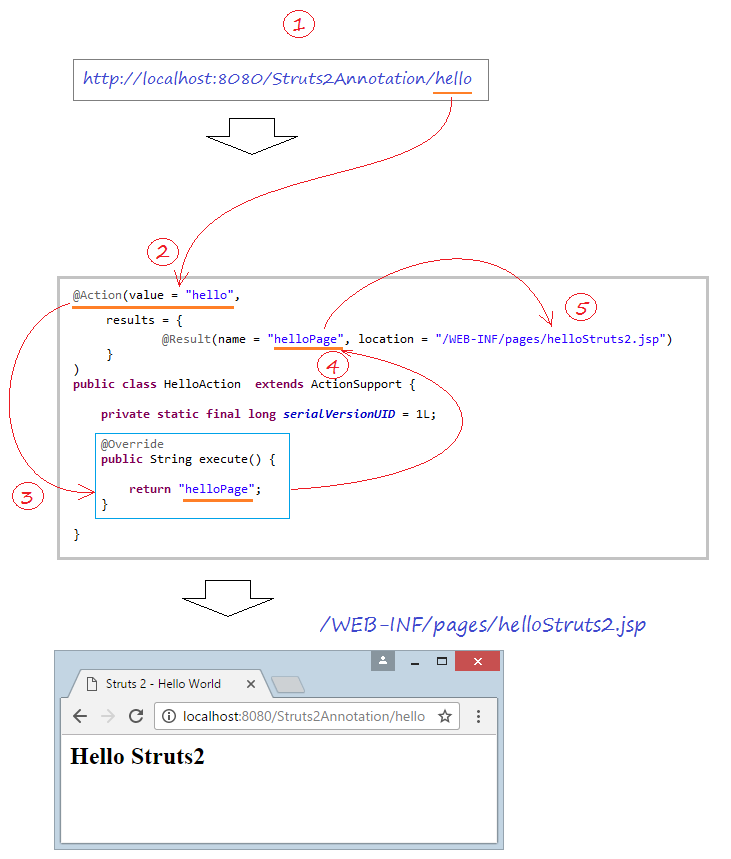
Wie kann Struts eine angemessene Action Klasse?
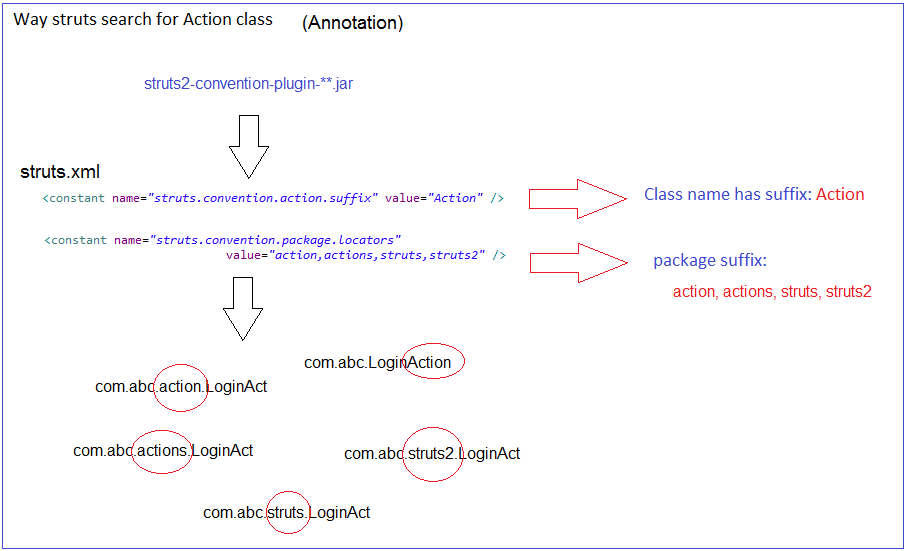
- Die Bibliothek struts2-convention-plugin-*.jar hat die Aufgabe zur Suche
- Sie liest struts2.xml um Ihre Hinweise zu sehen (wenn ja), umgekehrt sucht sie nach dem standardmäßigen Hinweise vom Struts.
- standardmäßig:
- Suche nach der Klasse mit dem Name, der mit Action endet
- Suche nach der Klasse mit dem Name von package, der mit : action, actions, struts, struts2.endet
Deshalb müssen Sie den Name von der Klasse Action nach dem obengemeinten Grundsatz stellen oder in struts2.xml nach Ihrem individuallen Grundsatz konfigurieren
